Initially this guide displays common birds of all types that are flying right now in our area. Use the selectors below to view rare birds, view birds flying any time, restrict the output to a certain shape of bird, or search by name.
New Mexico is on the western edge of the Central Flyway which is one of the major migration pathways between north and south for birds traveling between breeding and wintering grounds along the Rocky Mountains. This has resulted in the state having an incredible diversity of birds with over 550 different species reported. A little more than half of this number are sighted annually on the Pajarito Plateau. Some of these birds are full-time residents, some migrate here for a few weeks or months, and other are only seen briefly as they pass through the region.
This guide features many of the birds known to frequent Los Alamos county by when they are likely to be seen in the area. You can get additional information on local birds by joining PEEC Birders or going to the eBird website. eBird also includes lists of rare bird sightings and birding hot spots.
Bird References
Birdweb
Cornell Lab of Ornithology
eBird
eNature
Institute for Bird Populations
National Audubon Society
New Mexico Ornithology Society
What Bird
xeno-canto
Subject Area Experts (all guides)
Steve Cary (butterflies)
Beth Cortright (insects)
Terry Foxx (invasive plants)
Leslie Hansen (mammals)
Richard Hansen (fish, mammals)
Dorothy Hoard (butterflies, trees)
Chick Keller (flowers, herbarium)
Shari Kelley (geology)
Kirt Kempter (geology)
Garth Tietjen (reptiles)
David Yeamans (birds)
Web Development and Content Management
Pat Bacha
Jennifer Macke
Graham Mark
Akkana Peck
Contact
Please contact us for local nature questions and sightings. We welcome comments, corrections, and additions to our guides.
For more information about local nature, please visit our Nature Blog or subscribe to PEEC This Week.
Make Selection
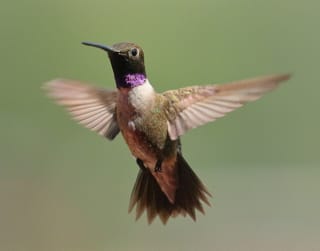 Photo: male by Bob Walker 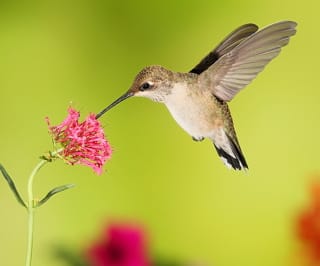 Photo: female by Bob Walker 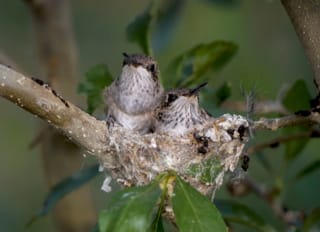 Photo: immatures by Mouser Williams |  Black-chinned Hummingbird, Alexander HummingbirdBCHU (Archilochus alexandri, Trochilus alexandri)Family: Trochilidae (Hummingbirds) Size: 3.3 - 3.8 in (8 - 10 cm) Flies: Apr 01 - Oct 15 Morphology: slender hummingbirds that are dull metallic green above and grayish white below with black mostly straight bills; males have a black throat with a thin, iridescent purple base; females have a pale throat and white tipped outer tail feather; immatures resemble females Status: native; common Food source: nectar and insects Habitat: alpine meadows, woodlands, thickets, chaparral, orchards Typical location: White Rock Black-chinned Hummingbirds are seen in large numbers during the summer wherever hummingbird feeders and flowers are present. They will feed at flowers while hovering but will both hover and perch at feeders. They will fly out to catch small insects, pluck them from foliage, or even pick them out of spider webs. In colder weather, these hummingbirds may ingest as much as three times their body weight in nectar in a single day. Males perform a courtship display that consists of flying back and forth in a U-shaped arc. The nest is a compact cup of plant fibers held together with spider webs and camouflaged on the outside. The incorporation of the spider silk allows the nest to stretch, expanding as the nestlings grow. Info Photos Distribution Frequency Featured |
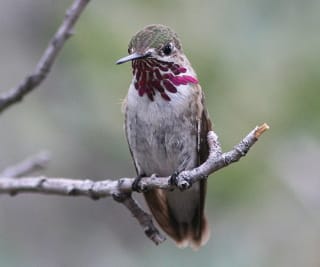 Photo: male by Hari Viswanathan 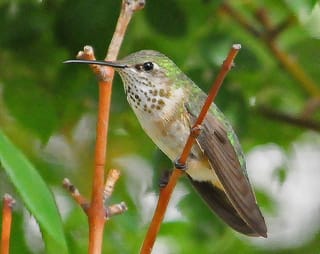 Photo: female by Jerry Oldenettel |  Calliope HummingbirdCAHU (Selasphorus calliope, Trochilus calliope)Family: Trochilidae (Hummingbirds) Size: 2.8 - 3.3 in (7 - 8 cm) Flies: Jun 15 - Oct 07 Morphology: these small birds look even smaller than they are due to a hunched posture; both males and females are green above and whitish below; males have a set of magenta rays on the throat and a light green wash on the sides; females have green stipling on the throat and a peach wash on the sides; immatures like females Status: native; locally common Food source: eats nectar and insects Habitat: montane, mixed conifer clearings, brushy edges, alpine meadows The Calliope Hummingbird is the smallest hummingbird in North America. Despite its small size, it can survive cold summer nights at high elevations and can be seen as altitudes as high as 11,000 feet (3,350 m). Typically these birds will feed while hovering at flowers that are close to the ground. They may also perch and fly out to capture insects midair or to pluck them from foliage. They are attracted to feeders with sugar-water mixtures. Nests are camouflaged, compact cups lined with things like plant down and spider webs. First flight is at about 3 weeks of age. Info Photos Distribution Frequency |
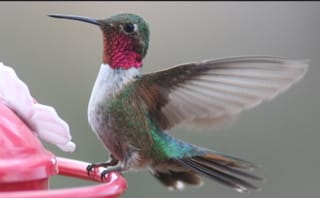 Photo: male by Selvi Viswanathan 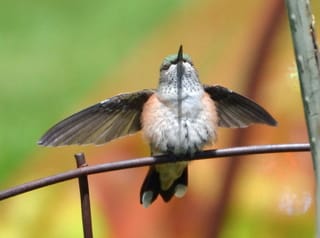 Photo: female by Lee Bill 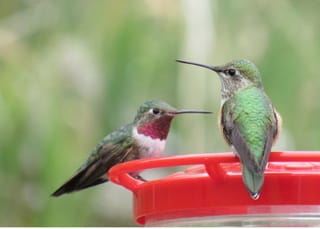 Photo: male and female by Deborah Halter |  Broad-tailed HummingbirdBTAH (Selasphorus platycercus, Trochilus platycercus)Family: Trochilidae (Hummingbirds) Size: 4 - 4.5 in (10 - 11 cm) Flies: Mar 15 - Oct 21 Morphology: both sexes have slender bodies, long tails, iridescent green upper parts, greenish/buffy flanks, white chest, and a line down the belly; males have a magenta gorget; females and immatures have a pale eyering and green spots on their throats and cheeks Status: native; common Food source: mostly nectar and tiny insects; particularly attracted to red flowers Habitat: pinyon-juniper, dry ponderosa pines, mixed fir forests, canyon vegetation Typical location: Los Alamos, White Rock The Broad-tailed Hummingbird has gotten its name from its tendency to spread out its tail feathers, flashing white tail tips. These birds can be seen in large numbers during the summer wherever hummingbird feeders and flowers are present. While they may perch at a feeder, they will usually feed while hovering, extending their long tongues to reach deep into the feeder or flower. They will also catch insects either by flying out to grab them or by plucking them off of foliage. Broad-tailed Hummingbirds will slow their metabolism and go into a state of torpor on cold nights. Nests are located in trees sheltered by an overhanging branch and are made of spider and plant materials covered with moss and bits of bark. Info Photos Distribution Frequency Featured |
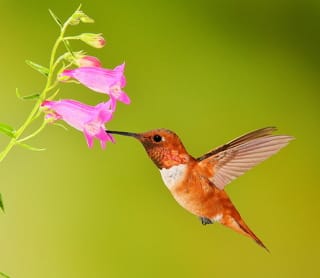 Photo: male by Bob Walker 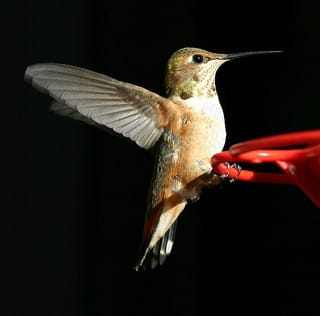 Photo: female by Mouser Williams .jpg) Photo: female nesting by Brendan Lally |  Rufous HummingbirdRUHU (Selasphorus rufus, Trochilus rufus)Family: Trochilidae (Hummingbirds) Size: 3.5 - 4.8 in (9 - 12 cm) Flies: Jun 15 - Oct 01 Morphology: both sexes have nearly straight bills, tapered tails, and fairly short wings; males are bright copper on back and belly with iridescent red throat; females are green above with rufous-washed flanks, rufous patches on the tail, and often a spot of copper on the throat Status: native; locally common Food source: Mostly nectar and insects; prefer red flowers Habitat: alpine meadows, forest edges Rufous Hummingbirds have the longest migration route of all North American hummingbirds. They travel from Mexico to as far north as Alaska. While they may perch at a hummingbird feeder, they will usually feed while hovering, extending their long tongues to reach deep into the feeder or flower. The first hummingbird to discover a food source, including feeders, defends it. It will perch on a nearby branch and intercept intruders in air with its angry buzzing. They have excellent memories and have been observed looking for a absent feeder that was there the previous year. These hummingbirds are fairly hardy as they can survive temperatures well below freezing given sufficient food and shelter. Males may mate with several females. Females are responsible for making the nest, incubating the eggs, and feeding the young. Nests are well concealed in coniferous trees or deciduous shrubs. Info Photos Distribution Frequency |
